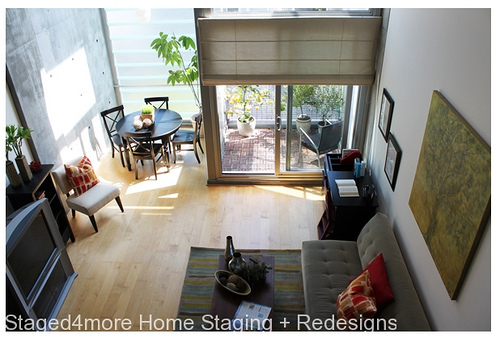As a real estate agent, I absolutely, positively agree with professional home stagers that staging works. People buy real estate on emotion, and staging creates what I call 'warm fuzzies.' Warm fuzzies translate to home sales. Here are some examples of how staging affects home buyers in my own community. It's probably the same for you:

by cindylinsf via fickr.com
- One of my listings looked terrible in the online photos. No one was clicking unless they were real estate investors looking for a deal. So we spruced up the outside with modern greenery and paint, took professional pictures, and overnight the showings tripled!
- Another listing was getting low-ball offers which the home sellers were rejecting. Once we staged the interior by removing the 'college dorm room' decor and added 'Pottery Barn' furnishings, they got a realistic offer that they accepted.
- All too often I walk through listings with buyers who recoil at the sloppy, cluttered household. They 'can't believe the seller could ask what he's asking' for the house. Yet we can go into a nearly identical house down the street that's perfectly clean and tidy, and suddenly they're in love'and at a higher price.
Staging matters. According to the Accredited Staging Professionals (ASP) group, FULLY staged homes sell in an average of 29 days compared to non-staged homes which sell in an average of 145 days. Addmittedly the ASP group's sample sizes may not be identical, but we get the point. Staging sells real estate.
As a real estate agent, it isn't easy to convince a home seller to stage, especially when they're already planning to pay you thousands to sell their home. (Yes, never mind that you haven't made that money yet.)
But it does raise the question, 'Should staging be part of your real estate service?' I say that it should, to whatever extent you can afford. If a home is priced correctly and you have every confidence it will sell, then staging is worth the risk. And it doesn't have to be much. For example, I am able to hire a housekeeper with an eye for detail to completely clean and then use the seller's existing furnishing to stage a home for under $400. It depends on the condition of the home and furnishings, but in the case of staging, sometimes a little goes a long way.
As an agent, or as a home seller, try to visualize how the buyer will see the house. Remember that a dated, shabby, or drab look, inside and out, may result in fewer qualified showings, lower offers, and longer market time. I do a staging checklist with sellers where we walk through and identify all the places they need to make changes before selling. For the most part, these are the kinds of things homeowners have lived with so long, that they go unnoticed. For instance, have you ever been in a someone's house and noticed a bit of black mold on the tub? Wouldn't you think the home owner would notice that? They don't, or they don't register that it matters.
Real estate agents can't always persuade home sellers to stage. But at least when you're taking the listing photos, please put the lid on the toilet down, get the dirty clothes pile out of the picture, and move the parked cars from the front. Your MLS photos should look like the marketing photos they are, not like snapshots.
Share your own staging stories below!
Be consistent. Be bold. Be smart. Linda Schneider is a real estate business coach for smart real estate agents who want to be more powerful in their business. Drop by RealEstateBusinessCoaching.com for more about selling skills and real estate marketing ideas to take your business to the next level.
0 komentar:
Posting Komentar